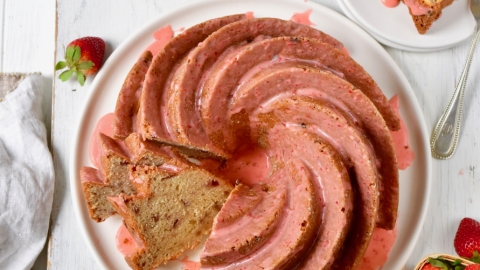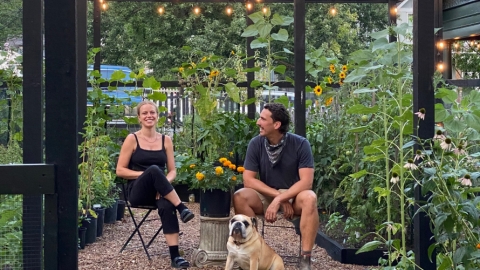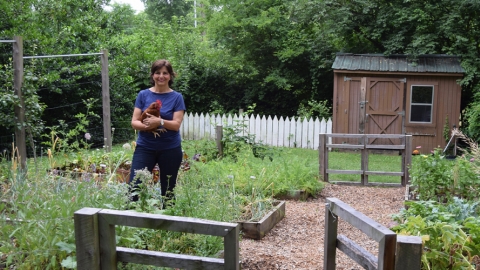Alisa Huntsman's Garden in Progress
Stepping into a well-tended garden that occupies a whole yard feels like gliding through the door of delight into a land of enchantment. At the garden of Alisa and Darry Huntsman, design, color, shape and scent harmonize into a lush, Edenic biome that seems effortless. Every sight line and corner holds something beautiful, clever or curious.
But there’s also the 500-gallon water tank, a reminder that it’s an investment and there are hard times. For the Huntsmans, it’s worth the labor for a harvest that feeds them and cultivates a healthy ecology.
Their yard-size garden (can we call it a “yarden”?) began in 2017 with a gentle approach to the difficult first task: humanely trapping and relocating the resident groundhog and raccoon. Then they enclosed the garden with a split-rail fence that supports muscadine vines.
The next job—the toughest—was the unspeakable effort to remove a quarter acre of turf.
But then, the fun part: they planted fig trees and bought some hens, which created a synergy.
The Huntsman hens spend their nights in a coop and their days in a clever chicken wire tunnel that stretches halfway around the garden perimeter. During the day, they eat pests and, uh, provide fertilizer. When the sun is too hot or they’re spooked by a hawk, they run under the fig trees.
You could call it beginner's luck. “We didn’t realize how big those trees would get,” says Alisa. “As much as we like to think we know what we’re doing, we are continually surprised by what we don’t know.” Whatever. It worked.
A quarter-acre Eden
The vegetable patch within the fence and chicken run is a changing lineup of okra, bean towers, carrots, onions, beets, potato hills, chard, Brussels sprouts, broccoli, cauliflower, three tomato types and a lettuce bed. The variety makes for a satisfying cycle: there’s always something sprouting or fading, on the verge of blooming or just starting to fruit.
Muscadines are not technically theirs—they’re on the property line the Huntsmans share with their Egyptian neighbor. The neighbor just wants the grape leaves; the Huntsmans get the grapes. Blueberry bushes and blackberry vines mean summer fruit and winter jams, juice and more.
The Huntsmans’ bees are catered to with flowers and herbs specially selected for them. Marigolds, zinnias, calendula and nasturtiums give the bees plenty to snack on. Bees also love the smorgasbord of the herb patch: oregano, basil, parsley, mint, sage, thyme, rosemary and chives.
Many of their heirloom herb and vegetable varieties are sourced from the legendary Baker Creek seed company. Barry’s Crazy Cherry tomato, for example, is a sprawling vine that despises trellising. If allowed to flop over, “it produces a ridiculous amount of tomatoes,” says Alisa. Dr. Wyche’s Yellow tomato, also from Baker Creek, yields hefty 1-pound fruits with a bright pumpkin color. The tomato bounty, says Alisa, becomes “every tomato product I’ll need for a year” in her pantry.
Alisa also likes to search the catalog of Kitazawa seed company for Asian greens, vegetables and herbs. If she’s feeling adventurous, Alisa buys Korean vegetable seeds at Fresh & Fresh International Market on Nolensville Road. “The instructions are in Korean. I don’t always know what I’m getting,” she says.
In a good year, the bounty feeds the Huntsmans well. Three of their kitchen cupboards are packed so tight with canned food that “nothing else will fit in there,” says Alisa. There’s also the big freezer where blanched broccoli, green beans, peas and squash take up about one third of the space.
Not as easy as it looks
Gardens, though, are never “set it and forget it.” The Huntsman garden is equal parts project experimentation, management, crisis control and course correction.
In 2021, they planted a Cascade hops vine because bees love the blossoms. The Cascade variety can grow 20–30 feet high, which seemed okay until they realized that “the weight was threatening to pull down the PVC chicken pen,” Alisa says. “We spent a year digging it out.”
There was that time she experimented with overwintering plants in the ground under plastic sheeting. If successful, it would yield vegetables much sooner than starting from seeds. But she hadn’t anticipated so much fungus also thriving underneath the plastic, subsequently infecting other plants and seedlings.
And there was the groundhog—not the original groundhog— who feasted on their bountiful vegetables. “The groundhog wiped out everything,” she says. The rascal was professionally relocated, and the Huntsmans wish him well. “I hope that groundhog survived.”
Also, skunks. Hers are multigenerational and she watched them grow up. They dig holes in her precious mulch pile in search of insects.
The Huntsmans themselves once relocated a raccoon to Percy Priest lake.
The drought of summer 2022—90 days above 90 degrees (except that one day in early August)—devastated their harvest. The long, waterless months stunted peaches before they ripened and wrecked Roma tomatoes. “We could see different parts of the city getting rain, then the storm would go around us.”
She kept waiting for the blueberries to ripen, then half of them shriveled up and died. Same with the blackberries. Pepper varieties that had thrived in prior years just conked out. And, unimaginably, the squash plant didn’t yield. “This is the South!” Alisa exclaims indignantly. “How do you not have yellow squash taking over?”
Jane of many trades
The garden is just one of Alisa’s many projects. Her Instagram handle, or one of them, is @janeofmanytrades. That well describes her continual learning, experimenting until something else catches her quick mind.
Before she was the gatekeeper at the garden of eatin’, Alisa spent years as a dessert maker and spectacular cake baker. She got super into tall cakes and wrote Sky High: Irresistible Triple-Layer Cakes (2007), with lavish photos of the lofty creations. You might have tasted her memorable desserts at the Loveless Cafe when she was the pastry chef in the 2010s. She wrote a cookbook based on her work there, Desserts From the Famous Loveless Cafe (2011). Both books are available on Amazon and both have 4+ star ratings. More recently, she baked for both Husk and Elliston Place Soda Shop.
For her, the impressive baking and confecting are sport. She’s not really a cake eater: she prefers biscotti. That’s another trade Alisa pursued. In the 1990s, she had a biscotti bakery—Mangia Biscotti—that supplied most area coffeehouses. She opened a retail shop in the Factory at Franklin as South City Baking Company, in the space where Five Daughters Bakery is currently. She makes a wicked good macaron, too, if you ask her.
And to bring it back to gardening, she’s also a Davidson County Master Gardener and is active in the chapter.
It’s no surprise that she had several different Instagram accounts before settling on Jane of Many Trades.
Market day and beyond
Some years she holds market days to sell whatever is too abundant in the yarden—this year, their wildflower honey, or tomatoes or bundles of herbs. She announces these on her blog Will Garden for Cake.
Selling her products isn’t a priority, though. The yarden was an interest that grew into a calling. It’s about feeding the Huntsmans, sure, but also about creating a sound, harmonious system that works with nature.
“If more people attempted to grow a few things in their own yard, imagine the difference it could make! The bees are eating when you do—if everybody with a yard planted a milkweed plant, to feed the monarchs it would make a huge difference.
“We see that difference in what we created here. If it were to go away, an entire ecosystem would disappear: the hummingbirds, the woodpeckers, the bees. When I see what we’ve done in five years, it scares me what would happen if this garden went away.
“The hardest part for me is knowing we will have to leave this house, because we know we can’t retire here, this is not our last stop. We know we will be leaving this, and that’s the part that worries me the most.” You can find Alisa at her blog or email info@alisahuntsman.com.


















